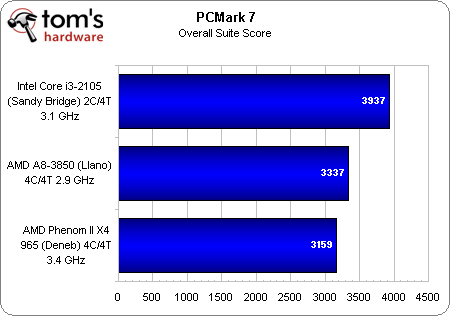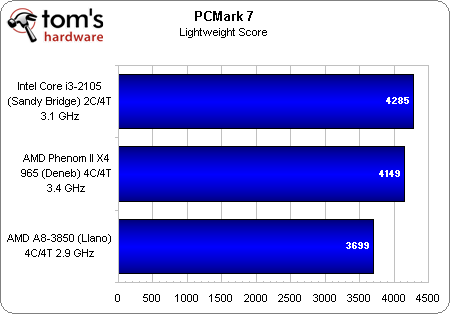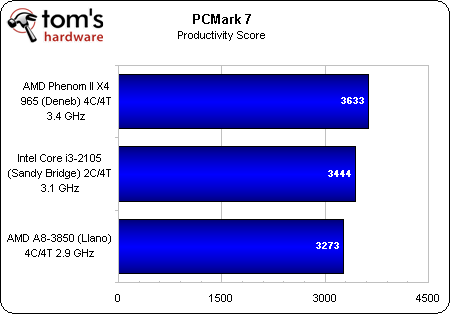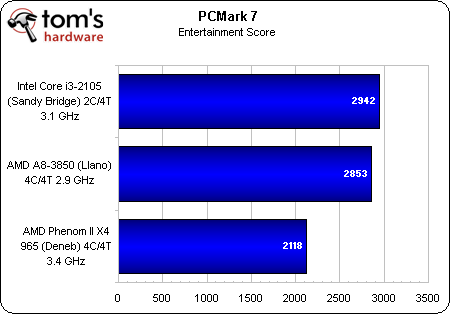AMD A8-3850 Review: Llano Rocks Entry-Level Desktops
Earlier this month we previewed AMD's Llano architecture in a notebook environment. Now we have the desktop version with a 100 W TDP. How much additional performance can the company procure with a loftier thermal ceiling and higher clocks?
Benchmark Results: PCMark 7
In light of AMD’s (and Nvidia’s and VIA’s) recent departure from BAPCo (and my subsequent reaction that I had no plans to use SYSmark in any of my testing anyway), I almost feel obligated to explain the value of starting our benchmarks with a look at synthetic performance from titles like PCMark 7, 3DMark Vantage, and SiSoftware Sandra.
Synthetic measures of performance are most useful when they effectively isolate a subsystem, taxing it in a way that real-world applications might not be able to. After all, real-world apps really shouldn’t aim to be bottlenecked by any particular piece of hardware. Meanwhile, a synthetic benchmark can make it its goal to push as much data across a certain bus, measure the efficiency of a parallelized processor, or evaluate a component’s handling of a specific algorithm.
To that end, PCMark 7 is moderately useful as a synthetic. Because it’s based on components of the Windows operating system, it’s real-world by nature. Futuremark scripts the tests in a way that’d be both difficult and time consuming for us to replicate.
The benchmark adds more comparative value by repeating each component three times and then generating an integer score by multiplying a coefficient value to the geometric mean of each suite’s resulting score. A score close to 5000 means you’re looking at performance close to the reference Core i7-980X, GeForce GTX 580, and Crucial C300 Futuremark used to establish its baseline.
The fact that none of these three systems approach 5000 is a good indication of their relative performance. These aren’t high-end configurations; they’re decidedly mainstream.
With that said, the workloads that comprise PCMark 7 clearly favor a processor-oriented focus over graphics. The Fusion initiative might be all about emphasizing entertainment, but the base PCMark suite is clearly slanted toward more productivity-based tasks.
Drill down into Futuremark’s whitepaper, and you see that this test consists of storage, video playback/transcoding, image manipulation, Web browsing, decryption, and DirectX 9 graphics. We’re actually a bit perplexed by the choice to use DX 9 when other components of PCMark 7 exploit DirectX 10, and indeed the company’s flagship benchmark, 3DMark 11, employs DirectX 11.
Get Tom's Hardware's best news and in-depth reviews, straight to your inbox.
And that's why I say PCMark is moderately useful. It's giving us valid results in the tests that it runs, which are Windows-based and consequently relevant. But if you only look at this one page of benchmarks, then you'll miss the point of AMD's design decisions entirely.
The Lightweight suite is even more processor-dependent, given its emphasis on storage, text editing, image manipulation, and Web browsing across three tabs. There is nothing here to tax the A8-3850’s graphics resources, and so Llano falls even further behind.
AMD is defended by its Phenom II X4 965, though, which costs a tad more than the Llano-based chip, but invests all of its transistors into four cores. Those resources are almost enough to catch the dual-core Core i3-2105, but not quite.
Given the results of the PCMark 7 and Lightweight suites, we weren’t expecting much from Llano in a test dominated by productivity tasks: storage, Web browsing, decryption, and text editing.
Sure enough, the A8-3850 takes a last-place finish. But then we have to ask the question: how much horsepower do you really need for fluid Web browsing? Can you really edit text fast enough to make your processor look slow? Those are the questions AMD is hoping potential customers will ask before weighing how much budget should go into a processor, how much should go into graphics, and can a piece of silicon that does both offer compelling-enough performance?
Although the A8-3850 doesn’t overtake Core i3-2105 here, it does demonstrate how a more entertainment-oriented workload favors AMD’s Fusion initiative.
Just bear in mind that PCMark is but one tool in the box of measurements we’ll use today. It’s neither the end-all nor be-all for predicting performance. As a case in point, let’s move on to another Futuremark title, 3DMark Vantage, to gauge gaming capability. Needless to say, the story is entirely different in that metric.
Current page: Benchmark Results: PCMark 7
Prev Page Test Setup And Benchmarks Next Page Benchmark Results: 3DMark Vantage-
SteelCity1981 So then what's the point of getting the Turbo Core versions when they are going to be Turbo Clocked slower then the none Turbo Clocked versions...Reply -
cangelini SteelCity1981So then what's the point of getting the Turbo Core versions when they are going to be Turbo Clocked slower then the none Turbo Clocked versions...Reply
They don't want you to see better performance from a cheaper APU in single-threaded apps by pushing Turbo Core further ;-) -
Known2Bone i really wanted see some amazing gains in the content creation department what with all that gpu power on chip... oh well games are fun too!Reply -
ivan_chess I think this would be good for a young kid's PC. It would be enough to run educational software and a web browser. When he grows up to be a gamer it would be time to replace the whole machine anyway.Reply -
DjEaZy ... it's may be not the greatest APU for desktop... but it will be a powerful thingy in a laptop... the review was nice... but in the gaming department... would be nice to see a standard 15,x'' laptop resolution tests @ 1366x768... or something like that...Reply -
Mathos Actually if you want good DDR3 1600 with aggressive timings, the Ripjaws X series memory that I have does DDR3 1600 at 7-8-7-24 at 1.5v, not all that expensive when it comes down to it either.Reply -
Stardude82 This makes little sense. An Athlon II X3 445 ($75) and a HD 5570 ($60, on a good day you can get a 5670 for the same price) would provide better performance for the same price ($135) and not have to worry about the RAM you use.Reply
So is AM3+ going to be retired in favor of FM1 in the near future? Why are there chipset at all? Why isn't everything SOC by now?
Otherwise this is a very good CPU. If AMD has used 1 MB level 2 caches in their quads when they came out with the Deneb Propus die, they would be much more competitive. -
crisan_tiberiu stardude82This makes little sense. An Athlon II X3 445 ($75) and a HD 5570 ($60, on a good day you can get a 5670 for the same price) would provide better performance for the same price ($135) and not have to worry about the RAM you use. what about power consumption?Reply




